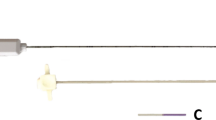Abstract
Aims
To evaluate the echogenicity of a commercially available needle, modified on the tip, by comparing two groups of patients undergoing to percutaneous biliary drainage.
Methods
In this retrospective analysis 16 percutaneous transhepatic biliary drainage (PTBD) procedures performed on 16 oncologic patients were evaluated. Patients were randomly divided into two groups of eight subjects each; in the first group, a standard needle was adopted (group A); in the second group, the needle was manually modified to create a rough surface (group B), by scrubbing the tip with an 11 scalpel blade for 150 s all around its surface. To objectively quantify US needle tip visibility, the contrast-to-noise ratio (CNR) was calculated analyzing B-mode images by positioning region of interests in correspondence of needle tip and liver parenchyma.
Results
Needle tip echogenicity was significantly higher in group B where the needle tip was modified compared to control group A (p value = 0.014). CNR, considered to objectively evaluate differences among needle tip echogenicity, was significantly higher in group B with respect to control group A (p value = 0.018).
Conclusions
The proposed method, scrubbing a 22 gauge commercially available needle tip with a scalpel blade, represents an effective technique to improve needle visibility during US-guided punctures of the liver.




Similar content being viewed by others
References
Russo G, Balocco P, Pozza S et al (2018) The role of contrast-enhanced ultrasound in ultrasound-guided biopsy of soft tissue tumors. Il Giornale Italiano di Radiologia Medica Marzo-Aprile 5(2):185–189
van de Berg NJ, Sanchez-Margallo JA, van Dijke AP et al (2019) A methodical quantification of needle visibility and echogenicity in ultrasound images. Ultrasound Med Biol 45(4):998–1009
Patel IJ, Davidson JC, Nikolic B et al (2012) Consensus guidelines for periprocedural management of coagulation status and hemostasis risk in percutaneous image-guided interventions. J Vasc Interv Radiol 23(6):727–736
Giurazza F, Corvino F, Contegiacomo A et al (2019) Safety and effectiveness of ultrasound-guided percutaneous transhepatic biliary drainage: a multicenter experience. J Ultrasound 22(4):437–445
Arif M, Moelker A, van Walsum T (2018) Needle tip visibility in 3D ultrasound images. Cardiovasc Interv Radiol 41(1):145–152
Altaman DG, Bland JM (1999) Statistics notes. Treatment allocation in controlled trails: why randomize? BMJ 318:1209
Filippiadis DK, Binkert C, Pellerin O, Hoffmann RT, Krajina A, Pereira PL (2017) CIRSE quality assurance document and standards for classification of complications: the CIRSE classification system. Cardiovasc Intervent Radiol 40:1141–1146
de Jong TL, van de Berg NJ, Tas L, Moelker A, Dankelman J, van den Dobbelsteen JJ (2018) Needle placement errors: do we need steerable needles in interventional radiology? Med Devices Evid Res 11:259–265
Baker JA, Soo MS, Mengoni P (1999) Sonographically guided percutaneous interventions of the breast using a steerable ultrasound beam. Am J Roentgenol 172:157–159
Cohnen M, Saleh A, Luthen R, Bode J, Modder U (2003) Improvement of sonographic needle visibility in cirrhotic livers during transjugular intrahepatic portosystemic stent-shunt procedures with use of realtime compound imaging. J Vasc Interv Radiol 14:103–106
Wiesmann T, Borntrager A, Zoremba M, Neff M, Wulf H, Steinfeldt T (2013) Compound imaging technology and echogenic needle design effects on needle visibility and tissue imaging. Reg Anesth Pain Med 38:452–455
Adebar TK, Fletcher AE, Okamura AM (2014) 3-D ultrasound-guided robotic needle steering in biological tissue. IEEE Trans Biomed Eng 61:2899–2910
Cabreros SS, Jimenez NM, Greer JD, Adebar TK, Okamura AM (2015) Remote electromagnetic vibration of steerable needles for imaging in power doppler ultrasound. IEEE Int Conf Robot Autom 2015:2244–2249
Harmat A, Rohling RN, Salcudean SE (2006) Needle tip localization using stylet vibration. Ultrasound Med Biol 32:1339–1348
Culp WC, McCowan TC, Goertzen TC et al (2000) Relative ultrasonographic echogenicity of standard, dimpled, and polymeric-coated needles. J Vasc Interv Radiol 11:351–358
Nichols K, Wright LB, Spencer T, Culp WC (2003) Changes in ultrasonographic echogenicity and visibility of needles with changes in angles of insonation. J Vasc Interv Radiol 12:1553–1557
Voloshin AG (2014) Four-dimensional ultrasound guidance during epidural anaesthesia. J Ultrasound 18(2):135–142
Kawai N, Minamiguchi H, Sato M et al (2012) Evaluation of vascular puncture needles with specific modifications for enhanced ultrasound visibility: in vitro study. World J Radiol 4(6):273–277
Bigeleisen PE, Hess A, Zhu R, Krediet A (2016) Modeling, production, and testing of an echogenic needle for ultrasoundguided nerve blocks. J Ultrasound Med 35:1319–1323
de Korte CL, Weijers G, Vriezema DM, Keereweer AR, Thijssen JM, Hansen HHG (2012) Quantitative analysis of coated needles for ultrasound guided intervention. In: Proc IEEE Int Ultrason Symp 1571–1574
Di Giovanni G, Curlo M, Mastronardi M, Grasso M, Fucilli F (2020) Portobiliary post percutaneous transhepatic cholangiography fistula treatment by embolization with microcoils. J Radiol Rev 7:416–421. https://doi.org/10.23736/S2723-9284.20.00028-4
Tufano A, Minelli R, Rossi E et al (2020) Inferior epigastric artery pseudoaneurysm secondary to port placement during a robot-assisted laparoscopic radical cystectomy. J Ultrasound. https://doi.org/10.1007/s40477-020-00442-1 (Online ahead of print)
Author information
Authors and Affiliations
Corresponding author
Ethics declarations
Conflict of interest
The authors declare that they have no conflict of interest.
Research involving human participants
All procedures performed in studies involving human participants were in accordance with the ethical standards of the institutional and national research committee and with the 1964 Helsinki Declaration and its later amendments or comparable ethical standards.
Informed consent
Informed consent was obtained from all individual patients included in the study.
Additional information
Publisher's Note
Springer Nature remains neutral with regard to jurisdictional claims in published maps and institutional affiliations.
Rights and permissions
About this article
Cite this article
Giurazza, F., Contegiacomo, A., Corvino, F. et al. Scrubbing needles: a simple and costless technique to improve needle tip visibility during US-guided liver interventions. J Ultrasound 25, 73–78 (2022). https://doi.org/10.1007/s40477-021-00561-3
Received:
Accepted:
Published:
Issue Date:
DOI: https://doi.org/10.1007/s40477-021-00561-3




